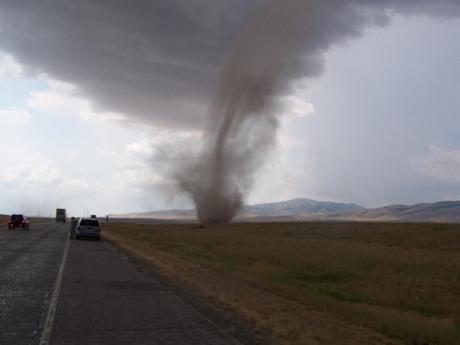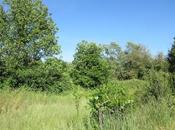
This is wind too, even if pretty dangerous
Ho ricevuto una e-mail (ma vi ricordo che potete anche lasciare un commento, miei cari lettori!) di una assidua lettrice che mi chiedeva di spiegarle a modo mio come nasce il vento. E allora continuiamo in questa rubrica della scienza-secondo-me, cercando di istoriarvi a modo mio come si crea il vento sul nostro pianeta.
In Meteorologia, il vento è definito come lo spostamento orizzontale di masse d’aria da un punto ad un altro. E cioè? Per capirlo, dobbiamo appuntarci alcuni assiomi fondamentali, che forse vi renderanno più semplici anche le parole del meteorologo alla tv. Così potrete anche ascoltare, oltre che guardare le icone della pioggia e del sole, come faccio io.
Alta pressione = freddo
Bassa pressione = caldo
Umidità = aria leggera
Non umidità= aria pesante
Segnato? Bene. Ora vi dirò una cosa che forse vi schioccherà come ha fatto con me: il vento nasce dal sole, perché senza il sole l’aria non si muoverebbe. Infatti, il sole riscalda l’aria, e l’aria si muove perché perde pressione, cioè aumenta di calore. Quando l’aria diventa calda, tende a muoversi. Questo significa che l’aria presente nelle aree di bassa pressione tende a spostarsi dove c’è alta pressione, ossia dove c’è freddo, perché quando l’aria calda prende più volume – ossia quando occupa più spazio - cerca un altro spazio più grande dove mettersi, diciamo. Proprio come i vestiti negli armadi delle donne.
Ovviamente, Più alta sarà la differenza di pressione tra alta e bassa, più alta risulterà la velocità di spostamento dell’aria, e quindi più forte risulterà anche il vento. A questo, c’è da aggiungere che ci sono elementi naturali che aiutano il vento a crearsi, oppure ne delimitano l’azione: una catena montuosa blocca il vento o lo trasforma da freddo a caldo, mentre una pianura ne aumenta il suo incedere impetuoso.
Che il vento si misuri con l’anemometro lo sapevo da quando da piccola facevo atletica e il sabato delle gare dei 100m avevo la paura di avere vento contro. Ma qual è lo schema generale che gli scienziati utilizzano per studiare la circolazione atmosferica del vento? É un meccanismo di circolazione termica a circuito chiuso chiamato cellula di Hadley, dal nome del suo scopritore – George Hadley – studioso del 1700. Siccome è troppo difficile da spiegare per il mio cervellino, vi affido a Wikipedia.
Affascinante, vero? Meno affascinante se pensate che anche un uragano – di fatto – è vento. Una cosa che genera morte creato dal centro unico della vita, il sole. Grottesco, non credete?
–
I received an e-mail (but remember you can also leave a comment, my dear readers!) from a dedicated reader who asked me to explain with my own words how wind is created. And then we keep going in this science for dummies topic, trying to explain it.
In meteorology, the wind is defined as the horizontal movement of air masses from one point to another. What does it mean? To understand this, let’s take a note some basic axioms, which perhaps will make the weatherman’s words on TV even easier to understand. So you can also listen to him, as well as watch the icons of rain and sun, as I usually do:
High pressure = cold
Low pressure = hot
Humidity = light air
No moisture = heavy air
Noted? All right. Now I’m going to tell you a thing that you might pop up as it did with me: the wind comes from the sun, because the air would not move without the sun.
In fact, the sun heats the air, and the air moves because it loses pressure, i.e. increases heat. When the air becomes hot, it tends to move. This means that the air into areas of low pressure tends to move where there is high pressure and so where it’s cold, because when the hot air takes more volume – i.e. when it occupies more space – has to look for more space. Just like clothes in women’s wardrobe.
Obviously, the higher will be the pressure difference between high and low, the higher will be the speed of movement of the air, so the wind will be much stronger too. Besides there are natural elements that help to create the wind or delineate the action: a mountain range blocks the wind and converts it from cold to hot while a plain increases wind’s wild pace.
I know that the wind is measured with an anemometer from when I was younger and I had the fear of having the wind against on Saturday’s 100m races. But what is the general pattern that scientists use to study the atmospheric circulation of the wind? It is a mechanism of thermohaline circulation in a closed circuit called Hadley cell, named after its discoverer – George Hadley – lived in 1700. Since it is too difficult to explain to my little brain, I commend you to Wikipedia.
Fascinating, isn’t it? Less attractive if you think that you think that hurricanes are wind too. A thing that generates death created by the root of all life, the sun. Grotesque, don’t you think?
Photo credit by David Dringle & KTVX-4
Ti potrebbe interessare anche questo! / Posts you might be interested in
- Eeek! Niente, per ora :)






